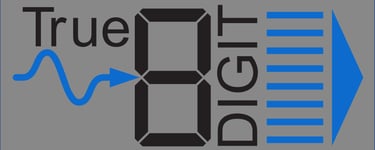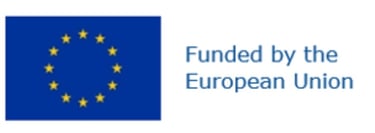Welcome to
Towards a true 8‐digit digitiser
NEWSLETTER issue 3 (Oct 2025)


Bottom-up development and research underpinning the design of a digitiser with state-of-the-art performance
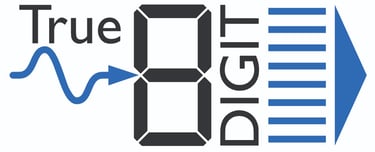

Introduction
Welcome to the third True8DIGIT project newsletter. The research activities within the project, aimed at the development of a digitiser with performance beyond the current state of the art, have been structured according to a two-step approach. The present phase focuses on establishing the groundwork necessary for a subsequent project and a follow-on is under preparation for the 2026 Industry call of the European Partnership for Metrology, in which a fully functional digitiser will be developed. This edition highlights some of the most relevant results and developments accomplished to date by the True8DIGIT consortium.
Project Final Workshop
Preparations are underway for the Final Workshop of the True8DIGIT project, which will provide an opportunity to present and discuss the project’s main outcomes, as well as to engage with stakeholders and industry representatives.
A one-day event in the first half of May 2026
IPQ – Caparica (Lisbon) – Portugal
Further details regarding the event’s date and programme will be shared in due course.
If you are interested to participate, please fill the registration form at
or contact events@true8digit.eu
Project status
The project has reached its 27th month of its 3 years duration period and is generally progressing according to schedule. All expected deliverables have been submitted and accepted.
Two final reports on specific aspects of the project, namely the characterisation of passive components and the design and testing of the timing solution have been produced and are available here: Search True8DIGIT (zenodo.org)
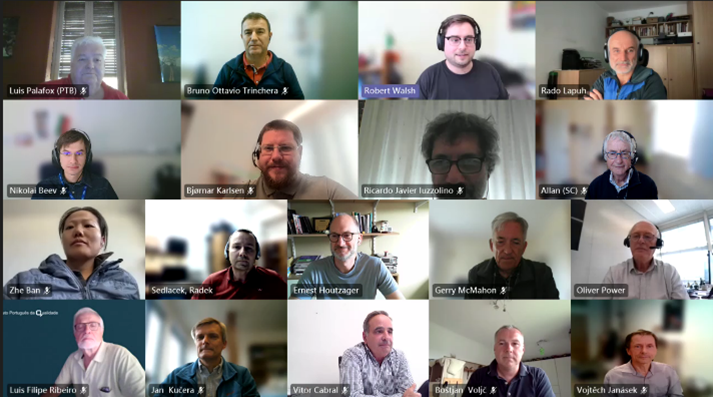

M27 Meeting
23 Sep 2025
To review the work done so far
To plan the next stages
To outline proposal for follow-on project
Project meetings
In addition to meetings between partners to discuss the development and progress of work against each work package, an online meeting involving the consortium, was organized.
Recent developments
Charge injection tests in CMOS switches
Timing platform with picosecond jitter and synchronization capability
Fabrication of ultra-quiet and low noise power supply
A set of methods have been developed and used for the characterization of the proposed timing platform for ADC synchronization.
The measurement method proposed enables the precise identification of key parameters of several signals from 1 Hz to 100 MHz in terms of frequency accuracy, short- and long-term stability, delay and time/phase jitter in the presence of several synchronization strategies based on conventional signals clocks and White Rabbit protocol.
An innovative set-up and measurement method for metrological assessment of charge injection phenomena has been developed. The proposed measurement method enables precise characterization of charge injection in discrete CMOS switches mounted in dedicated chip carriers, utilizing air-dielectric capacitor standards and a traceable digital sampling multimeter. Moreover, the temperature dependence of charge injection was investigated by modifying one of the carrier boards.
The experimental setup achieves a resolution of 1 pC, and the Type-A uncertainty ranges from 10 fC to 70 fC. The overall measurement uncertainties did not exceed 7 % for charge injection values below 5 pC, and 3 % for values between 50 pC to 350 pC. The method is self-validated since all the equipment are calibrated against the national standards.
A first demonstrator of the power supply unit (PSU) was fabricated. The design is based on automated switching of battery cell banks, ensuring continuous operation of the output power rails, providing voltages from +-5 V up to +-18 V. A dedicated system of switching relays was designed to ensure low leakage between banks in the charging and in the loading mode. PSU is passing through testing procedures to characterize its properties. Stability, low intrinsic noise, and high isolation are key parameters that are of interest.
Digitiser Characterisation using ultra-pure sinewaves
Advances in Parallel SAR ADC Operation
A number of ultra-pure sinewave oscillators, suitable for measuring the distortion of high-resolution digitisers have been identified. One model, provided by a project collaborator (http://www.janascard.cz/aHome.html) has been shown to have harmonic amplitudes below -150 dBc. Work is on-going to use these oscillators to characterise the non-linearity of AD4630, which is a 24-bit SAR ADC as well as the digitizing functions of the Keysight 3458A and Fluke 8588A.
A blind phase optimisation algorithm was used to determine residual DAC path harmonic phases in an audio analyser, where the harmonic amplitudes were measured using a special high performance sine analyser mode. Using this information for generating pre-distorted WAV files, this DAC path demonstrated resulting sine waves generated with harmonic distortion below -145 dBc and THD for all harmonics up to the Nyquist frequency below 0.00001 % (at 1 kHz signal and 48 kHz sampling rate).
The performance gains achievable through parallel operation of SAR ADCs have been investigated. Tests have been performed on one commercial 24-Bit, 2 MSPS Dual Channel SAR ADC evaluation board using an high-performance, modular 2-channel audio analyzer. Tests were conducted in both single-channel and parallel configurations. The evaluation focused on key dynamic performance metrics: THD, SINAD and Effective Number of Bits (ENOB). The results clearly showed the benefits of channel parallelisation and averaging. The ENOB increased by about 1.26 bits, while the noise floor improved from -154 dBc to -162 dBc. In the best case, the system achieved SINAD values up to 105.7 dB and ENOB of 17.5 bits.
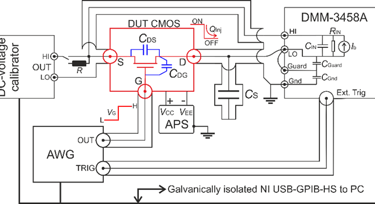

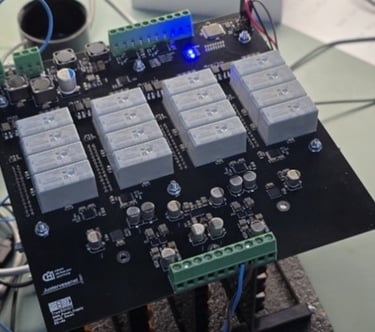

The method was presented at the IEEE I2MTC 2025 conference, and a paper has been published. (doi: 10.1109/I2MTC62753.2025.11079162).
A galvanically isolated solution based on optical link and solid-state device has been proposed and characterized using the same set of proposed methods.
All the measurement methods employed provide traceability of the device under test to the atomic reference standards.
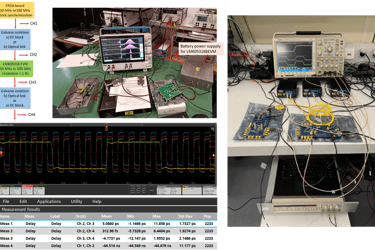





Dissemination
Towards a true 8-digit digitiser – EU Project overview and progress, High Performance Digitizer and DC Metrology, Feb 2024.
Measuring Wideband Nonlinearity in Analog to Digital Converters, Allan Belcher and Luis Palafox, paper accepted for publication at IEEE - I2MTC May, 20-23, 2024 Glasgow. Open access Measuring wideband nonlinearity of analog to digital converters.
Quadrature Bridge for Non-linearity measurement, Vojtech Janásek, Nikolai Beev, Boštjan Voljč, Rado Lapuh, CPEM 2024, Jul 2024, Denver, Colorado.
Digital Multimeters Voltage Sampling Performance Comparison, Rado Lapuh, Jan Kučera, Jakub Kováč, Boštjan Voljč, CPEM 2024, Jul 2024, Denver, Colorado.
Is a digitizer with sub-ppm accuracy feasible? Oliver Power, Rado Lapuh, Bjørnar Karlsen, Jan Kučera, Bruno Trinchera, Allan Belcher, NCSLI 2024 Workshop & Symposium, Jul 2024, Denver, Colorado.
Progress Report on 22RPT02 True8DIGIT project and prospects for a follow-on project, EURAMET TC-EM meeting, Oct 2024.
True8DIGIT project aims to provide the groundwork for the next generation of precision digitisers, Oliver Power, Electronics World, February 2025, Vol 130, Issue 2043, pp 44-45, Electronics World February 2025 :: 46.
Traceable characterization and simulation of charge injection in CMOS electronic switches, B. Trinchera, P. Durandetto and R. Iuzzolino, 2025 IEEE International Instrumentation and Measurement Technology Conference (I2MTC), Chemnitz, Germany, May 2025, pp. 1-6, DOI: 10.1109/I2MTC62753.2025.11079162.
accepted for presentation: Characterization of Passive Components for Use in a Precision Integrating Analogue-To-Digital Converter, IMEKO TC4 Workshop at a Special Session at XVI Semetro, 1-4 December 2025, Maceió - Alagoas, Brazil.
Technical Deliverables
Report on metrological methods for characterisation of resistors, capacitor and electronic switches for use in ADCs, 22RPT02-True8DIGIT-Deliverable D3, Nov 2024.
Timing and Synchronization Platform suitable for use in precision digitizers, 22RPT02-True8DIGIT-Deliverable D6, Jul 2025.
The key standard for our paper Measuring wideband nonlinearity of analog to digital converters is IEC 60748-4-3. This I2MTC paper was submitted though IEEE standards committee TC10. The relevant IEC committee is SC47A. IEC standards committees already have members who are also IEEE members, so the aim is to propose an update to IEC 60748-4-3 though collaboration with IEEE TC10 members and members of IMEKO TC4.
Representation on Standards Committees
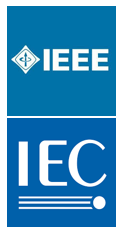

True8DIGIT Contacts
If you're interested in becoming a stakeholder and directly benefiting from the project outputs or if you'd like to learn more about the work carried out in each WP, feel free to reach out to
Funded by the European Union. Views and opinions expressed are however those of the author(s) only and do not necessarily reflect those of the European Union or EURAMET. Neither the European Union nor the granting authority can be held responsible for them.
The project (22RPT02 True8DIGIT) has received funding from the European Partnership on Metrology, co-financed from the European Union’s Horizon Europe Research and Innovation Programme and by the Participating States.The UK participant in Horizon Europe Project 22RPT02 True8DIGIT is supported by UKRI grant number 10,084,012 (Signal Conversion Ltd).
